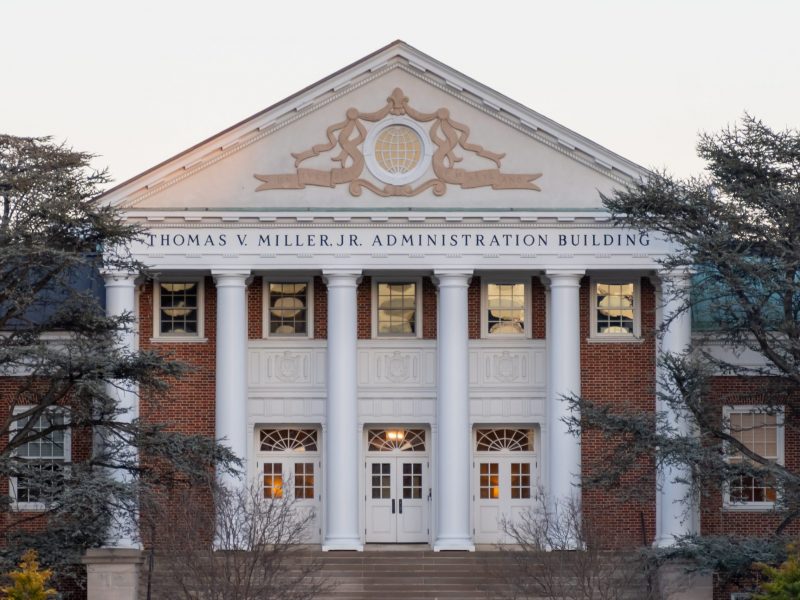Yesterday’s ribbon cutting ceremony at the new Biosciences Research Building was largely symbolic.
Despite some notable setbacks – last summer flash floods destroyed $7 million worth of air conditioning units in the basement and last semester a small fire started in a closet – the equipment and labs in the new building were up and running by May.
But the high profile brought to the event by notables such as Gov. Martin O’Malley, the leaders of both the Maryland Senate and House of Delegates and the county executive was not for nothing. With the formal announcement, the university is looking to reverse a reputation for run-down science labs that some say have driven researchers and professors elsewhere.
“In this world, you either have to move forward or move backward,” said university President Dan Mote in an interview after the ceremony, which drew a crowd of about 100 to the Hornbake Mall Tuesday. “Before this building we were moving backwards, there’s no doubt about that, so this is a symbol and a reflection of us moving forward.”
Mote admitted that the university had lost prospective professors in the past because the research facilities were in such bad shape. But it wasn’t just the loss of valuable talent that rankled, Mote said. As more and more people saw the dilapidated lab space, they told their colleagues throughout the country and gave the university a bad reputation as a research institution.
Karen Carleton, a biology assistant professor, can attest to the boost given researchers by the new bioscience building. Recruited to the university a year ago, Carleton had a lab in the H.J. Patterson building while the bioscience building was still under construction.
Among the horror stories she said circulated around the department was one about a colleague’s work ruined by a leaky roof in the corner of one lab. The incident happened before Carleton came to the university, but she said she made sure to keep her work away from that corner of the lab – just in case.
“The lab in HJP is full of character,” she joked, noting that it didn’t even have basic materials such as distilled water. “This new one is bright and spacious and has more stable electricity.”
The state of the old labs was enough to drive one professor clear off the campus.
Richard Webb, a nanotechnology researcher in the physics department, got fed up after frequent electrical outages ruined his experiments on more than one occasion. His research material needed to be kept at extremely low temperatures, but the outages would thaw his samples and leave them useless. Webb packed up and went to the University of South Carolina in 2004.
The woeful state of the campus laboratories led to a nine-year effort by university officials and the College of Chemical and Life Sciences to lobby state politicians for funding for the new bioscience lab. Gov. Bob Ehrlich secured a place in the budget for the research facility.
The 134,000 square foot building, which holds 34 labs for over 300 research scientists, is now home to many pieces of large, cutting-edge equipment. Much of the equipment, including high performance computing programs and real time PCR for sequencing and genomics, allow for close monitoring and tracking of molecular or electric activity. One lab is using a monitoring device to track the electrical reactions of cells to various solutions; the results of these tests could ultimately lead to an understanding of how the body would react to potential treatments.
Richard Payne, the chair of the biology department, said that in addition to the $64 million price tag on the building, the university spent about $12 to $13 million on initial operating fees and to purchase new equipment.
Each of the building’s four floors is dedicated to a specific area of research: plant biology, sensory neuroscience, comparative and functional genomics and host-pathogen interactions, which studies how diseases spread and how they attack the host’s body.
Along with Gov. Martin O’Malley, Mote was joined yesterday in dedicating the new building by Maryland Senate President Mike Miller, Speaker of the Maryland House of Delegates Michael Busch and County Executive Jack Johnson, each of whom spoke at the dedication ceremony.
All of those who spoke touched on the significance of bioscience as an increasingly significant field of research, saying they expected the new building would propel the university into the world of competitive modern research.
In his remarks, Miller praised Mote’s dedication to promoting research on the campus and recalled first meeting the university president. “I wanted to talk about basketball and football,” he said. “And he wanted to talk about bioscience research.”
ecksteindbk@gmail.com


